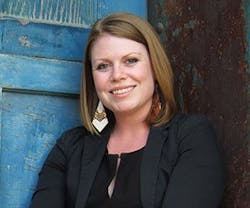Right off the bat, I’m going to say this isn’t the most stunningly beautiful issue we’ve ever produced. You probably won’t flip through the pages salivating over gears and motors (although I could be wrong; personally, I find mechanics pretty damn sexy). You may not put this issue on the lobby coffee table for people to flip through or get momentary synaptic stimulation from the pictures alone.
And that’s OK.
We all know that design is not purely aesthetic with beautifully upholstered chairs and
perfectly plush carpet tiles. Quite often, designers need to specify things in which
function and use are paramount over purely aesthetics: automatic shades for offices (Product Breakdown, p. 34), the perfect outdoor electrical hub (Product Q+A, p. 36), or the just-right fabric for hospital furniture which is beautiful in and of itself, but proves beauty is more than skin-deep (Product Inspiration, p. 50).
And that’s OK.
My aim every month is to provide our readers with the sourcing information they’ll need on hand. It’s OK if we aren’t on the lobby coffee table because we want to be your resource at your desk or during meetings so that when you ask, “Where did I see that product?” you know it’s going to be found in our pages. I want you to close the magazine every time you read it knowing something more about the background of a product than you did before or finding interest in an offering with which you weren’t previously familiar.
While the images in this issue may not be as runway-worthy as others, the products themselves are just as intriguing as any other we’ve published.
We designers are curious creatures, and our Research+Development issue could very well be the “We Never Learned to Stop Asking ‘Why?’” issue. I’ve said it before in editorials, but I know I never learned to stop asking why, and I know from the many readers who have previously emailed me about that line that many of you didn’t either.
When I saw Cityline by Teknion (Product Evolution, p. 44) during NeoCon this past summer,
I couldn’t help but crawl under some of the furniture and ask, “But how is the frame’s mechanism designed?” The product engineers eagerly crawled after me, demonstrating with 3D-printed prototypes the ways in which one “simple” piece (which are usually the hardest parts to design) makes the entire product click, unsnap, rearrange, and click together again in moments.
Is the underside of a table the most aesthetically pleasing portion of a product? Usually not. And that’s OK. But we here at i+s are going to continue to get our hands dirty and crawl around on the ground if it means we’re providing you with the information you need about useful, new—or new to you—products.
Kadie Yale | Editor-in-Chief
About the Author

Kadie Yale
Former Editor-in-Chief
Kadie Yale holds a BA in Industrial Design from San Francisco State University and a MA in Decorative Art History and Theory from Parsons the New School. In her role as editor-in-chief from 2015-2018, she led the interiors+sources team in creating relevant content that touches on sustainability, universal design, science, and the role of design in society.
